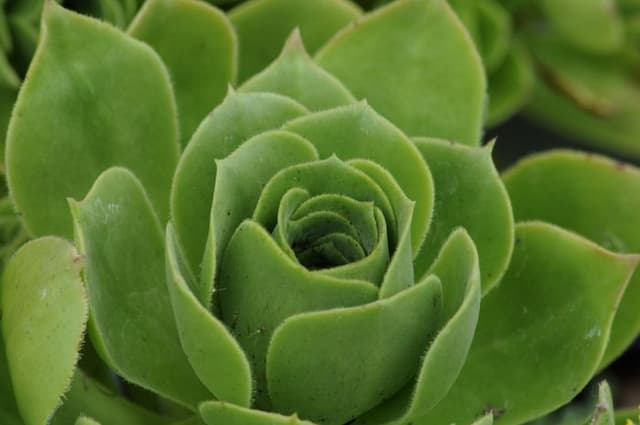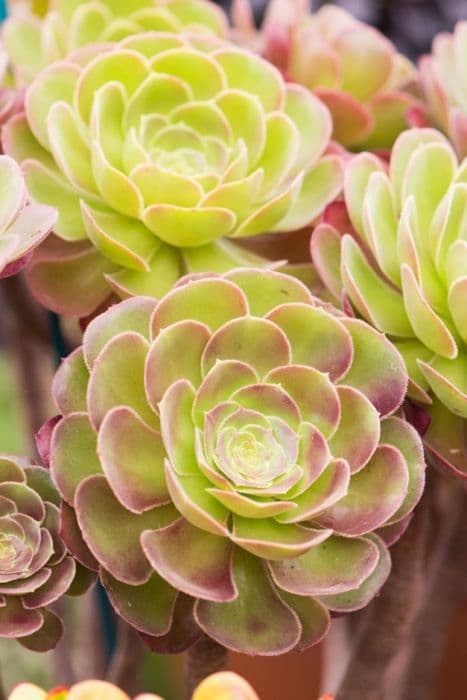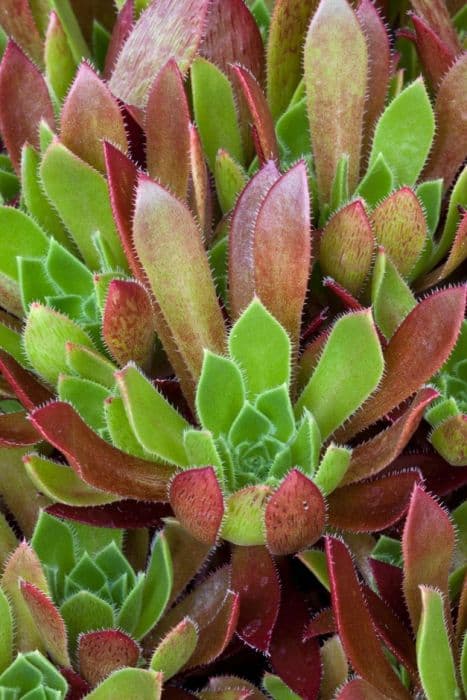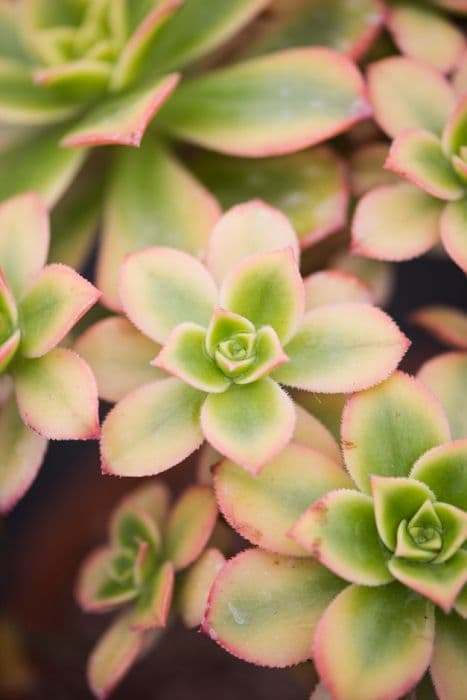Ice Plant Hylotelephium spectabile 'Iceberg'

ABOUT
The 'Iceberg' is a perennial plant known for its striking foliage and flowers. It typically has fleshy, succulent leaves that are gray-green in color. These leaves often assume a rounded, spoon-shaped form and form a whorled pattern around stout, upright stems. The overall appearance of the leaves can give the plant a somewhat sculptural appeal. In late summer to early fall, the 'Iceberg' bursts into bloom with dense clusters of small, star-shaped flowers. These blossoms are predominantly white, providing a crisp, clean look that contrasts beautifully with the grayish-green foliage. The flower clusters can be quite prominent and tend to attract butterflies and other pollinators to the garden. The stems of the 'Iceberg' are robust and upright, supporting the weight of the blooms without the need for staking. The plant exhibits a clump-forming habit, with each individual stem contributing to the overall mounded shape. When in flower, it can become a focal point in the garden due to its considerable floral display. Throughout the seasons, the 'Iceberg' displays a hardy vitality, and its leaves may take on a slight reddish tinge when exposed to cooler temperatures before the onset of winter, adding another layer to its decorative appeal. As a garden plant, it is valued not only for its aesthetic qualities but also for its ease of care and ability to withstand periods of drought once established. The 'Iceberg' is often used in borders, rock gardens, and as a complement to other perennials with contrasting colors and textures.
About this plant
 Names
NamesFamily
Crassulaceae
Synonyms
Showy Stonecrop, Iceberg Sedum, Butterfly Stonecrop
Common names
Sedum spectabile 'Iceberg'.
 Toxicity
ToxicityTo humans
The plant commonly known as Stonecrop is not considered highly toxic to humans. However, ingestion of the plant, particularly in large amounts, could potentially cause gastrointestinal upset, including symptoms such as nausea, vomiting, and diarrhea. It is generally recommended to avoid eating or handling any part of the plant excessively, and washing hands after contact is advisable to prevent any potential irritation.
To pets
Stonecrop is also not considered highly toxic to pets, but as with humans, ingestion can cause mild gastrointestinal discomfort. Symptoms in pets might include vomiting, diarrhea, and lethargy. It is best to keep an eye on your pet if they have ingested this plant and consult with a veterinarian if symptoms seem severe or persistent.
 Characteristics
CharacteristicsLife cycle
Perennials
Foliage type
Deciduous
Color of leaves
Gray-green
Flower color
White
Height
1-2 feet (30-60 cm)
Spread
1-2 feet (30-60 cm)
Plant type
Succulent
Hardiness zones
3-9
Native area
Asia
Benefits
 General Benefits
General Benefits- Attracts Pollinators: Hylotelephium spectabile 'Iceberg', commonly known as Iceberg Sedum, draws in bees, butterflies, and other beneficial insects, supporting the local ecosystem.
- Drought Tolerant: Iceberg Sedum is well-suited to dry environments as it requires minimal watering, making it ideal for water-wise gardens.
- Low Maintenance: This plant is easy to care for, requiring little upkeep beyond occasional pruning, thus perfect for gardeners of all skill levels.
- Decorative Appearance: With its attractive foliage and blooms, Iceberg Sedum adds aesthetic value to gardens, containers, and landscaping projects.
- Winter Interest: The sturdy stems and seed heads of Iceberg Sedum can remain visually appealing even in winter, providing texture and interest in the off-season.
- Soil Adaptability: It is adaptable to a variety of soil conditions, although it prefers good drainage, making it a versatile choice for many garden settings.
- Pest Resistance: Iceberg Sedum is generally resistant to pests and diseases, reducing the need for chemical treatments in the garden.
 Medical Properties
Medical PropertiesThis plant is not used for medical purposes.
 Air-purifying Qualities
Air-purifying QualitiesThis plant is not specifically known for air purifying qualities.
 Other Uses
Other Uses- As a living roof plant: Sedum 'Iceberg' is often used in green roofs due to its drought tolerance and hardiness, providing insulation and helping to manage rainwater runoff.
- In butterfly gardens: This plant acts as a nectar source for butterflies and other pollinators, enhancing biodiversity in garden spaces.
- For garden art: The distinctive, fleshy leaves and flower clusters of Sedum 'Iceberg' can be used in creative garden designs to form patterns or even living sculptures.
- For erosion control: Sedum 'Iceberg' can be planted on slopes or banks to help stabilize the soil and prevent erosion with its dense root system.
- As a groundcover: The plant's mat-forming growth habit makes it an excellent groundcover option, reducing weed emergence and covering bare soil.
- In container gardens: Sedum 'Iceberg' does well in containers, adding an appealing aesthetic for patios and balconies due to its succulent leaves and attractive blooms.
- For culinary experiments: While not a common edible, some parts of sedums are edible and can be tried in small quantities as a novel ingredient in salads or as a garnish after proper identification and ensuring no pesticides or harmful chemicals are used.
- As a drought-tolerant lawn alternative: Sedum 'Iceberg' can be used as a low-water, low-maintenance alternative to traditional grass lawns in appropriate climates.
- In xeriscaping: The sedum is suitable for xeriscapes, a landscaping method that reduces or eliminates the need for irrigation, due to its drought-resistant nature.
- As an educational tool: Gardeners and educators can utilize Sedum 'Iceberg' to teach about succulent care, water-wise gardening, and plant propagation techniques.
Interesting Facts
 Feng Shui
Feng ShuiThe Ice Plant is not used in Feng Shui practice.
 Zodiac Sign Compitability
Zodiac Sign CompitabilityThe Ice Plant is not used in astrology practice.
 Plant Symbolism
Plant Symbolism- Resilience: Hylotelephium spectabile 'Iceberg', commonly known as Ice Plant or Stonecrop, often symbolizes resilience due to its ability to withstand drought and poor soil conditions.
- Endurance: The Ice Plant's hardy nature and longevity represent endurance and the ability to thrive in challenging environments.
- Tranquility: With its subtle hues and cool-toned appearance, the Ice Plant is associated with tranquility and calmness, reflecting a sense of peace.
- Adaptability: The adaptability of the Ice Plant to different growing conditions can symbolize flexibility and the willingness to adjust to life's circumstances.
- Strength: Its sturdy stems and leaves convey a message of strength and support, resembling the ability to bear burdens and remain strong.
- New Beginnings: The Ice Plant's propensity for growth and spreading can signify new beginnings and the start of new ventures or phases in life.
 Water
WaterThe Ice Plant, commonly known as 'Iceberg', should be watered deeply but infrequently, as it is drought-tolerant. Generally, watering once every two weeks is sufficient during the growing season. In cooler temperatures, you can reduce the frequency. Ensure that you provide enough water to soak the soil to a depth of about an inch. Always allow the soil to dry out between waterings to prevent root rot. It's better to underwater than overwater this succulent.
 Light
Light'Iceberg' Ice Plant thrives best in full sunlight. Ideally, place the plant where it gets at least six hours of direct sun daily. While it can tolerate some light shade, especially in extremely hot climates, full sun encourages the most robust growth and flowering.
 Temperature
TemperatureThe 'Iceberg' Ice Plant prefers temperatures between 65 and 75 degrees Fahrenheit but can tolerate a range down to 40 degrees and up to 90 degrees Fahrenheit. Avoid exposing the plant to temperatures below freezing, as it is not frost-tolerant and can suffer damage or die if left in cold conditions below 32 degrees Fahrenheit.
 Pruning
PruningPruning the 'Iceberg' Ice Plant should be done to remove spent flowers and to maintain its shape. Pruning can encourage new growth and enhance flowering. The best time to prune is in late winter or early spring, before new growth begins. Occasionally, you may need to trim back overgrown parts during the growing season to keep the plant looking tidy.
 Cleaning
CleaningAs needed
 Soil
SoilSedum 'Iceberg' thrives in well-draining soil with a pH range from 6.0 to 7.5. A mix of one-third sand, one-third garden soil, and one-third peat or compost works best for proper drainage and fertility.
 Repotting
RepottingSedum 'Iceberg' should be repotted every 2 to 3 years to refresh the soil and accommodate the growth of the plant, as it does not like to be overly root-bound.
 Humidity & Misting
Humidity & MistingSedum 'Iceberg' prefers a dry to average humidity environment and is quite tolerant of arid conditions, further exemplifying its drought-resistant nature.
 Suitable locations
Suitable locationsIndoor
Place Sedum 'Iceberg' near a sunny window and ensure good air circulation.
Outdoor
Plant Sedum 'Iceberg' in full sun and well-draining ground or a raised bed.
Hardiness zone
Sedum 'Iceberg' is suitable for USDA zones 3-9.
 Life cycle
Life cycleThe life of Ice Plant 'Iceberg' (Hylotelephium spectabile 'Iceberg') begins as a seed, which, when sown, germinates in warm conditions. After germination, a seedling emerges and establishes roots and a small rosette of succulent leaves. Over time, the plant enters a vegetative stage, growing larger, developing a sturdy stem, and producing a fuller rosette. During its maturity, in late summer to early fall, the Ice Plant blooms, displaying clusters of star-shaped, white to pale pink flowers that attract pollinators. After flowering, it sets seed, which may drop to the ground to produce new plants or be collected for propagation. In winter, Ice Plant may die back, especially in colder climates, but its root system remains alive to begin new growth in the spring.
 Propogation
PropogationPropogation time
Early Spring
Hylotelephium spectabile 'Iceberg', commonly known as Ice Plant, is often propagated by cuttings. The best time to take cuttings for propagation is in the late spring or early summer when the plant is actively growing. To propagate by cuttings, identify a healthy stem and cut a piece approximately 3 to 4 inches (about 7.5 to 10 centimeters) long, making sure it has a few leaves. Remove the lower leaves to expose a short length of stem. Allow the cutting to callous over for a day or two to prevent rot, and then insert it into a well-draining soil mix. Keep the soil moist but not waterlogged, and place the cutting in a warm, bright location out of direct sunlight. Roots should develop in a few weeks, after which the new plant can be transplanted into a larger pot or directly into the garden.









